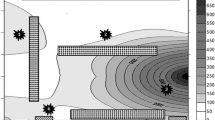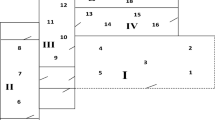Abstract
Sixty two filamentous fungi isolated from paint coatings, wallpaper, carton-gypsum board, and indoor air in buildings were screened for acid activity. It was found that 64.5% of strains produce acids on medium with bromo-cresol purple, where 18% of the strains were distinguished by very high acid activity (acid activity coefficient Q = 1.32–2.83), including the species:Aspergillus niger, Aspergillus versicolor, Penicillium expansum, Penicillium brevicom pactum, Penicillium chrysogenum, Cladosporium cladosporioides, Stachybotrys chartarum, Mucor globosus, Ulocladium chartarum andAlternaria alternata. Research indicated that filamentous fungi considerably decrease the pH of the medium when that medium containing building material. The greatest acid production and pH decrease of the medium was observed during the growth of filamentous fungi in a medium with mortar, while the production of acids was less in a medium with cartongypsum board, gypsum, and wallpaper. Filamentous fungi produced succinic, oxalic, malic and fumaric acids in the medium with indoor building materials. It was stated that the type of building material affects the spectrum and quantity of organic acids produced by filamentous fungi.
Similar content being viewed by others
References
Abin L., Coto O., Gomez Y., Bosecker K. (2002). Screening of fungi with capacity for organic acid production. Rev. Biol., 16: 69–71.
de La Torre M.A., Gomez-Alarcon G., Melgarejo P., Saiz-Jimenez C. (1991). Fungi in weathered sandstone from Salamanca cathedral, Spain. Sci. Tot. Environ., 107: 159–168.
de La Torre M.A., Gomez-Alarcon G. (1994). Manganese and iron oxidation by fungi isolated from building stone. Microb. Ecol., 27: 177–188.
Flannigan B., McCabe E., McGarry F. (1991). Allergic and toxigenic microorganisms in houses. J. Appl. Bacteriol., 70: 61–73.
Flannigan B., Samson R.A., Miller J.D., Eds (2001). Microorganisms in Home and Indoor Environments, 1st edn., Taylor and Francis Inc., London and New York.
Gaylarde C.C., Morton L.H.G. (1999). Deteriogenic biofilms on buildings and their control: review. Biofouling, 14: 59–74.
Gomez-Alarcon G., de La Torre A. (1994).The effect of filamentous fungi on stone monuments: the Spanish experience. In: Singh J., Ed., Building Mycology. Management of Decay and Health in Buildings. Chapman and Hall, UK, pp. 295–309.
Gomez-Alarcon G., Munoz M.L., Flores M. (1994). Excretion of organic acids by fungal strains isolated from decayed sandstone. Int. Biodeter. Biodegr., 34: 169–180.
Gu J.D., Ford T.E., Berke N.S., Mitchell R. (1998). Biodeteriration of concrete by the fungusFusarium. Int. Biodeter. Biodegr., 41: 101–109.
Gutarowska B., Żakowska Z. (2002). Elaboration and application of mathematical model for estimation of mould contamination of some building materials based on ergosterol content determination. Int. Biodeter. Biodegr., 49: 299–305.
Gutarowska bl]B., Żakowska bl]Z. (2009). Mathematical models of mycelium growth and ergosterol synthesis in stationary mould culture. Lett. Appl. Microbiol., 48: 605–610.
Hippelein M., Rügamer M. (2004). Ergosterol as an indicator of mould growth on building materials. Int. J. Hyg. Environ. Health, 207: 379–385.
Magnuson J.K., Lasure L.L. (2004). Organic acid production by filamentous fungi. In: Tkacz J.S., Lange L., Eds, Advances in Fungal Biotechnology for Industry, Agriculture and Medicine. Kluwer Academic, Plenum Publisher, pp. 307–339.
May E., Lewis F.J., Pereira S., Tayler S., Seaward M.R.D., Allsopp D. (1993). Microbial deterioration of building stone — a review. Biodeterioration Abst., 7: 109–123.
Morton G. (2003). Microbiology of paint coatings — some new trends. Proceedings of the Third Conference Microbial Biodegradation and Biodeterioration of Technical Materials, Łódź, Poland, pp. 1–10.
Nielsen K.F., Thrane U., Larsen T.O., Nielsen P.A., Gravesen S. (1998). Production of mycotoxins on artificially inoculated building materials. Int. Biodeter. Biodegr., 42: 8–16.
Ortega-Calvo J.J., Hernandez-Marine M., Saiz-Jimenez C. (1991). Bioterioration of building materials by cyanobacteria and algae. Int. Biodeter. Biodegr., 28: 165–186.
Palmer R.J., Siebert J., Hirsch P. (1991). Biomass and organic acids in sandstone of a weathering building: production by bacterial and fungal isolates. Microb. Ecol., 21: 253–266.
Samson R.A., Hoekstra E.S., Frisvad J.C., Filtenborg O. (2000). Introduction to food and air borne fungi, 6th edn., Centraalbureau Voor Schimmelcultures, Utrecht.
Tuomi T., Reijula K., Johnsson T., Hemminki K., Hintikka E.L., Lindroos O., Kalso S., Koukila-Kähkölä P., Mussalo-Rauhamaa H., Haahtela T. (2000). Mycotoxins in crude building materials from water-damaged buildings. Appl. Environ. Microbiol., 66: 1899–1904.
Van Lancker F., Adams A., Delmulle B., De Saeger S., Moretti A., Van Peteghem C., De Kimpe N. (2008). Use of headspace SPME-GC-MS for the analysis of the volatiles produced by indoor molds grown on different substrates. J. Environ. Monitor., 10: 1127–1133.
Warscheid Th., Braams J. (2000). Biodeterioration of stone; a review. Int. Biodeter. Biodegr., 46: 343–368.
Wasserbauer R. (2003). Microbial biodeterioration of building materials and constructions. Proceedings of the Third Conference: Microbial Biodegradation and Biodeterioration of Technical Materials, Łódź, Poland, pp. 17–27.
Author information
Authors and Affiliations
Corresponding author
Rights and permissions
About this article
Cite this article
Gutarowska, B., Czyżowska, A. The ability of filamentous fungi to produce acids on indoor building materials. Ann. Microbiol. 59, 807–813 (2009). https://doi.org/10.1007/BF03179227
Received:
Accepted:
Issue Date:
DOI: https://doi.org/10.1007/BF03179227




